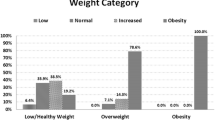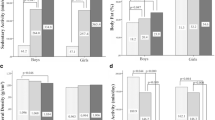Abstract
The aim of this study was to associate the epidemiology of whole body, peripheral, and central adiposity with sociodemographic characteristics, health-related behaviors, and biological maturation of adolescents from a Brazilian state capital. A cross-sectional school-based study was conducted in Florianopolis, Santa Catarina, Brazil with 818 adolescents aged 14 to 18 years, and 61.8% female. The peripheral adiposity was assessed by the triceps skinfold thickness and the central adiposity by the subscapular skinfold thickness, using cutoff greater than or equal to percentile 90 of the Centers for Disease Control and Prevention reference curve. Adolescents with high whole body adiposity were those showing skinfold thickness values above the reference percentile. Logistic regression analysis was applied using multivariable model. The prevalence of high whole body, peripheral, and central adiposity was 8.0%, 8.7%, and 10.3% for boys and 3.8%, 6.3%, and 11.1% for girls, respectively. Factors associated with this outcome in boys were overweight/obesity and low aerobic fitness (p < 0.05). Besides these factors, girls were also associated with excessive body fat, low paternal schooling, and puberty status (p < 0.05). Physical activity, sedentary behavior, and eating habits were not associated with this outcome. It was concluded that the main predictors of high body adiposity were overweight and low aerobic fitness in both sexes and low parental schooling and puberty status in females.
Similar content being viewed by others
References
Addo OY, Himes JH (2010) Reference curves for triceps and subscapular skinfold thicknesses in US children and adolescents. Am J Clin Nutr 91:635–642
Andersen LB, Hasselstrøm H, Grønfeldt V, Hansen SE, Karsten F (2004) The relationship between physical fitness and clustered risk, and tracking of clustered risk from adolescence to young adulthood: eight years follow-up in the Danish Youth and Sport Study. Int J Behav Nutr Phys Act 1:6
Anderssen SA, Cooper AR, Riddoch C, Sardinha LB, Harro M, Brage S, Andersen LB (2007) Low cardiorespiratory fitness is a strong predictor for clustering of cardiovascular disease risk factors in children independent of country, age and sex. Eur J Cardiovasc Prev Rehabil 14:526–531
Bouchard C, Tremblay A, Leblanc C, Lortie G, Sauard R, Theriault G (1983) A method to assess energy expenditure in children and adults. Am J Clin Nutr 37:461–467
Brazilian Association of Research Companies. Brazil Economic Classification Criterion (2003) http://www.abep.org/codigosguias/ABEP_CCEB.pdf. Accessed 10 April 2005
Brazilian Institute of Geography and Statistics. Household Budget Survey 2008–2009. http://www.ibge.gov.br/home/estatistica/populacao/condicaodevida/pof/2003medidas/default.shtm. Accessed 02 December 2010
Brazilian Institute of Geography and Statistics. IBGE cidades. http://www.ibge.gov.br/cidadesat/topwindow.htm?1. Accessed 22 October 2010
Canadian Society for Exercise Physiology (2003) The Canadian Physical Activity, Fitness and Lifestyle Appraisal: CSEP's guide to health active living, 2nd edn. Canadian Society for Exercise Physiology, Ottawa
Children, adolescents, and television (1995) American Academy of Pediatrics Committee on Communications. Pediatrics 96:786–787
Cole TJ, Bellizi MC, Flegal KM, Dietz WH (2000) Establishing a standard definition for child overweight and obesity worldwide: international survey. BMJ 320:1240–1243
Duquia RP, Dumith Sde C, Reichert FF, Madruga SW, Duro LN, Menezes AM, Araújo CL (2008) Epidemiology of elevated triciptal and subscapular skinfolds in adolescents. Cad Saúde Pública 24:113–121
Frisch RE, McArthur JW (1974) Menstrual cycles: fatness as a determinant of minimum weight for height necessary for their maintenance or onset. Science 185:949–951
Garnett SP, Cowell CT, Baur LA, Shrewsbury VA, Chan A, Crawford D, Salmon J, Campbell K, Boulton TJ (2005) Increasing central adiposity: the Nepean longitudinal study of young people aged 7–8 to 12-13y. Int J Obes (Lond) 29:1353–1360
González DA, Nazmi A, Victora CG (2010) Growth from birth to adulthood and abdominal obesity in a Brazilian birth cohort. Int J Obes (Lond) 34:195–202
Goran MI (1998) Measurement issues related to studies of childhood obesity: assessment of body composition, body fat distribution, physical activity, and food intake. Pediatrics 101:505–518
Guedes DP, Lopes CC, Guedes JERP (2005) Reproducibility and validity of the International Physical Activity Questionnaire in adolescents. Rev Bras Med Esporte 11:151–158
Heyward VH (1998) Practical body composition assessment for children, adults, and older adults. Int J Sport Nutr 8:285–307
Kappel DB (2007) Early childhood development index in Brazil: regional analysis. Rev Bras Educ 12:232–240
Livingstone B (2000) Epidemiology of childhood obesity in Europe. Eur J Pediatr 159:S14–S34
Lohman TG (1992) Advances in body composition assessment. Human Kinetics, Champaign
Lubans DR, Morgan PJ, Aguiar EJ, Callister R (2011) Randomized controlled trial of the Physical Activity Leaders (PALs) program for adolescent boys from disadvantaged secondary schools. Prev Med 52(3–4):239–246
Maldonado G, Greenland S (1993) Simulation study of confounder-selection strategies. Am J Epidemiol 138:923–936
Mukhopadhyay A, Bhadra M, Bose K (2005) Regional adiposity, body composition and central body fat distribution of 10–16 years old Bengalee boys of Nimta, North 24 Parganas, West Bengal, India. Coll Antropol 29:487–492
Neovius M, Linné Y, Barkeling B, Rössner S (2004) Discrepancies between classification systems of childhood obesity. Obes Rev 5:105–114
Nguyen B, Kornman KP, Baur LA (2011) A review of electronic interventions for prevention and treatment of overweight and obesity in young people. Obes Rev doi:10.1111/j.1467-789X.2010.00830.x
Rodriguez Añez CR, Reis RS, Petroski EL (2008) Brazilian version of a lifestyle questionnaire: translation and validation for young adults. Arq Bras Cardiol 91:92–98
Stamatakis E, Wardle J, Cole TJ (2010) Childhood obesity and overweight prevalence trends in England: evidence for growing socioeconomic disparities. Int J Obes (Lond) 34:41–47
Strong WB, Malina RM, Blimkie CJ, Daniels SR, Dishman RK, Gutin B, Hergenroeder AC, Must A, Nixon PA, Pivarnik JM, Rowland T, Trost S, Trudeau F (2005) Evidence based physical activity for school-age youth. J Pediatr 146:732–737
Tanner JM (1962) Growth at adolescence. Blackwell, Oxford
Turconi G, Guarcello M, Maccarini L, Bazzano R, Zaccardo A, Roggi C (2006) BMI values and other anthropometric and functional measurements as predictors of obesity in a selected group of adolescents. Eur J Nutr 45:136–143
Ulijaszek SJ, Kerr DA (1999) Anthropometric measurement error and the assessment of nutritional status. Br J Nutr 82:165–177
United Nations. Human Development Index, Municipal 1991 and 2000. All cities in Brazil. http://www.pnud.org.br/atlas/ranking/IDH-M%2091%2000%20Ranking%20decrescente%20(pelos%20dados%20de%202000).htm. Accessed 10 March 2010.
Van Lenthe FJ, Kemper CG, van Mechelen W (1996) Rapid maturation in adolescence results in greater obesity in adulthood: the Amsterdam Growth and Health Study. Am J Clin Nutr 64:18–24
Victora CG, Huttly SR, Fuchs SC, Olinto MT (1997) The role of conceptual frameworks in epidemiological analisys: a hierarchical approach. Int J Epidemiol 26:224–227
Wang Y, Monteiro C, Popkin BM (2002) Trends of obesity and underweight in older children and adolescent in the United States, Brazil, China and Russia. Am J Clin Nutr 75:971–977
Wells JC (2007) Sexual dimorphism of body composition. Best Pract Res Clin Endocrinol Metab 21:415–430
Conflicts of interest
The authors declare that there are no conflicts of interest.
Author information
Authors and Affiliations
Corresponding author
Rights and permissions
About this article
Cite this article
Silva, D.A.S., Pelegrini, A., de Lima e Silva, J.M.F. et al. Epidemiology of whole body, peripheral, and central adiposity in adolescents from a Brazilian state capital. Eur J Pediatr 170, 1541–1550 (2011). https://doi.org/10.1007/s00431-011-1460-3
Received:
Accepted:
Published:
Issue Date:
DOI: https://doi.org/10.1007/s00431-011-1460-3




